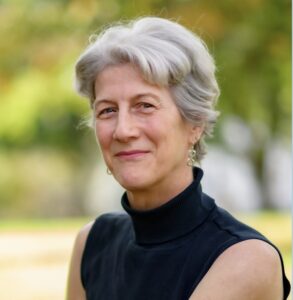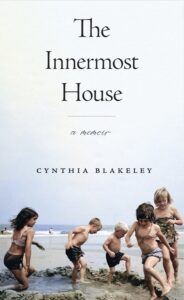Cynthia Blakeley’s account of growing up in a working-class, chaotic household in 1960s Wellfleet is a memoir. But categorizing The Innermost House that way is as inadequate as calling Wellfleet a beach town. There’s more to it than that.

Blakeley, a freelance editor and academic who teaches courses in memoir writing and theories of dream interpretation at Emory University, set out to write the story of her family in the mid-1990s. She organized the project around a group of oral histories she’d conducted with relatives who’d led colorful and, in some cases, tragic lives.
She spent time “looking under the hood of other peoples’ memoirs to see how and why they worked so well,” she says. Then, in response to a literary agent’s suggestion, she forged her own path, using the stories she’d gathered as well as her own recollections to look at memory formation and what she calls “narrative identity.” The result is a powerful exploration of how memories take shape or slip from consciousness and how the things we remember or choose to forget shape our sense of self.
The title of Blakeley’s book pays homage to The Outermost House, Henry Beston’s 1928 memoir chronicling the year he spent in a cottage on Eastham’s back shore. And though Blakeley shares Beston’s appreciation for the beauty of the Outer Cape, she’s more focused on interiors, both mental and physical, as she attempts to make meaning of her turbulent childhood in a rambling house on LeCount Hollow Road in South Wellfleet.
Each chapter of The Innermost House, published in 2024 by the University of Massachusetts Press, highlights a different facet of memory. There is the “impossible memory” of a seismic event that Blakely couldn’t recall firsthand because it happened when she was still in her mother’s womb — the almost inconceivable arrest of Shirley Blakeley on charges of infidelity in the late 1950s. The author learned of the arrest and the subsequent abuse her mother suffered at the hands of her ex-husband through an interview with her mother and a search of legal records. She writes: “Though I couldn’t see the violence … science tells me I could feel it, and while I can’t consciously remember it, my body surely holds its traces.”
Another chapter illustrates the way emotion fuels and distorts memories. Blakely remembered how she feared her father, who would whip his children with a belt for the slightest infraction. It wasn’t until much later that she grew to appreciate the beach outings and vacations he organized for his children and the structure he provided as their mother descended into alcoholism.
“The powerful link between emotion and memory might explain why I for so long privileged more painful memories when I told others the story of my father,” Blakeley writes. “Emotion is memory’s jet fuel and landing gear. Affective intensity influences which of our memories are likely to be encoded and recalled, and which will reappear in vivid, well-defined images.”
At times the focus on the architecture of memory feels like a distraction from the compulsively readable narrative. In addition to the vivid scene of her mother’s arrest, Blakeley writes about a harrowing sexual assault, an in-law’s attempted suicides, encounters with ghosts, her ocean baptism as a teenage born-again Christian, and revealing exchanges with a former school bully. For Blakely, school was a refuge, and academic success allowed her to escape “over the bridge” and become the first in her family to attend college.
Blakeley’s relationship with her erratic mother grounds the story. Shirley Blakeley, who died in 2014, was an accomplished seamstress and waitress at local restaurants (the Oyster House, the Lighthouse). Her wit, good looks, and charm attracted men of varying stripes, some abusive, others kind. She was compassionate and generous, delivering food to elderly shut-ins but also capable of disregarding the needs of her own children, leaving them hungry while she went out to bars with friends.

“Mom’s secrets once dragged me under with the force of a hook snared in the belly,” Blakeley writes, “but her translation of those secrets into shared stories helped me to wriggle the hook free, to loosen my overidentification with her.”
Arguably the most interesting aspect of Blakeley’s memory project is not what is pieced together from interviews, journals, and dreams but what she comes to appreciate about forgetting. The school bully forgot her own bad behavior, Blakeley surmises, because it “allowed her to imagine better versions of herself.” The act of forgetting, she says, “can create room, like negative space in art or silence, for other ways of being or meanings to arise.”
The ability to forget trauma — or to remember, process it, and move on — has allowed Blakeley to retain her happiest memories of the Outer Cape. She writes of a midnight swim: “I dove in where the luminous sea met the diamond-flecked sand, the water’s silent, silky lift of my hair a caress. I kept my aim straight toward the horizon, my body immersed in liquid light, my nostrils tingling with salt, the spaces between my toes scoured and washed clean.”
Blakeley returns to Wellfleet each year from her home in Atlanta. It is here that she still feels most connected to the natural world.
“I’m no longer poor, and I don’t have to deal with anyone’s alcoholism,” she says. “Those parts are now foggier in my mind. What’s uppermost is: this feels like home. I am swept away by the beauty of the place.”
Homecoming
The event: Cynthia Blakeley talks about The Innermost House
The time: Sunday, July 27, 6 p.m. and Thursday, July 31, 7 p.m.
The place: East End Books, 389 Commercial St., Provincetown (July 27) and Wellfleet Public Library (July 31)
The cost: Free; RSVP at eventbrite.com for July 27



